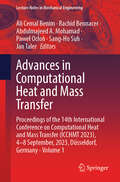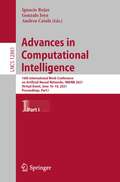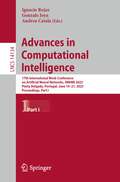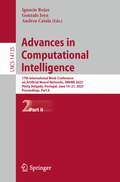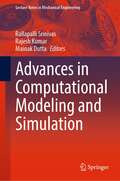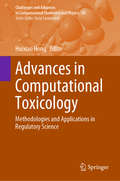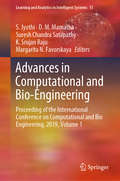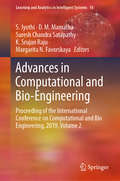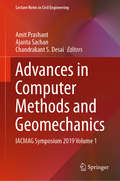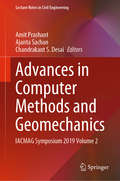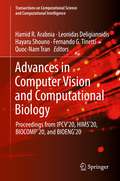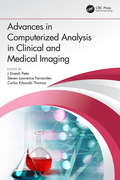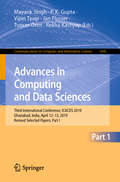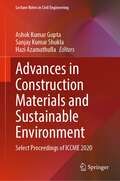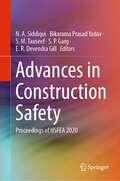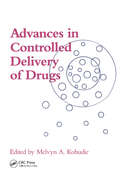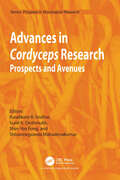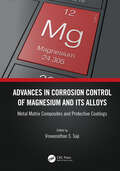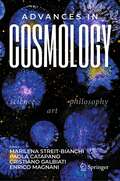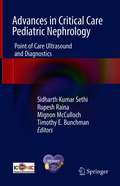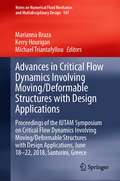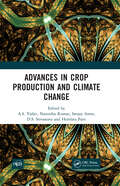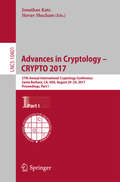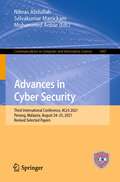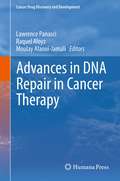- Table View
- List View
Advances in Computational Heat and Mass Transfer: Proceedings of the 14th International Conference on Computational Heat and Mass Transfer (ICCHMT 2023), 4-8 September, 2023, Düsseldorf, Germany, Volume 1 (Lecture Notes in Mechanical Engineering)
by Jan Taler Paweł Ocłoń Ali Cemal Benim Rachid Bennacer Abdulmajeed A. Mohamad Sang-Ho SuhThis book reports on cutting-edge applied research and methods in the area of heat and mass transfer and computational fluid dynamics. With a special emphasis on computational methods, it covers applications to different fields, including mechanical engineering, aerospace, and energy, among others. Some relevant experimental validations are described as well. Being the first volume of the two-volume proceedings of the 14th International Conference on Computational Heat and Mass Transfer, ICCHMT 2023, held on September 4-8, 2023, in Düsseldorf, Germany, this book offers a timely perspective of research and applications in the field of computational heat and mass transfer. It also provides both academics and professionals with extensive information and a source of inspiration for new developments and collaborations.
Advances in Computational Intelligence: 16th International Work-Conference on Artificial Neural Networks, IWANN 2021, Virtual Event, June 16–18, 2021, Proceedings, Part I (Lecture Notes in Computer Science #12861)
by Ignacio Rojas Gonzalo Joya Andreu CatalaThis two-volume set LNCS 12861 and LNCS 12862 constitutes the refereed proceedings of the 16th International Work-Conference on Artificial Neural Networks, IWANN 2021, held virtually, in June 2021.The 85 full papers presented in this two-volume set were carefully reviewed and selected from 134 submissions. The papers are organized in topical sections on Deep Learning for Biomedicine, Intelligent Computing Solutions for SARS-CoV-2 Covid-19, Advanced Topics in Computational Intelligence, Biosignals Processing, Neuro-Engineering and much more.
Advances in Computational Intelligence: 17th International Work-Conference on Artificial Neural Networks, IWANN 2023, Ponta Delgada, Portugal, June 19–21, 2023, Proceedings, Part I (Lecture Notes in Computer Science #14134)
by Ignacio Rojas Gonzalo Joya Andreu CatalaThis two-volume set LNCS 14134 and LNCS 14135 constitutes the refereed proceedings of the 17th International Work-Conference on Artificial Neural Networks, IWANN 2023, held in Ponta Delgada, Portugal, during June 19–21, 2023.The 108 full papers presented in this two-volume set were carefully reviewed and selected from 149 submissions.The papers in Part I are organized in topical sections on advanced topics in computational intelligence; advances in artificial neural networks; ANN HW-accelerators; applications of machine learning in biomedicine and healthcare; and applications of machine learning in time series analysis. The papers in Part II are organized in topical sections on deep learning and applications; deep learning applied to computer vision and robotics; general applications of artificial intelligence; interaction with neural systems in both health and disease; machine learning for 4.0 industry solutions; neural networks in chemistry and material characterization; ordinal classification; real world applications of BCI systems; and spiking neural networks: applications and algorithms.
Advances in Computational Intelligence: 17th International Work-Conference on Artificial Neural Networks, IWANN 2023, Ponta Delgada, Portugal, June 19–21, 2023, Proceedings, Part II (Lecture Notes in Computer Science #14135)
by Ignacio Rojas Gonzalo Joya Andreu CatalaThis two-volume set LNCS 14134 and LNCS 14135 constitutes the refereed proceedings of the 17th International Work-Conference on Artificial Neural Networks, IWANN 2023, held in Ponta Delgada, Portugal, during June 19–21, 2023. The 108 full papers presented in this two-volume set were carefully reviewed and selected from 149 submissions. The papers in Part I are organized in topical sections on advanced topics in computational intelligence; advances in artificial neural networks; ANN HW-accelerators; applications of machine learning in biomedicine and healthcare; and applications of machine learning in time series analysis. The papers in Part II are organized in topical sections on deep learning and applications; deep learning applied to computer vision and robotics; general applications of artificial intelligence; interaction with neural systems in both health and disease; machine learning for 4.0 industry solutions; neural networks in chemistry and material characterization; ordinal classification; real world applications of BCI systems; and spiking neural networks: applications and algorithms.
Advances in Computational Modeling and Simulation (Lecture Notes in Mechanical Engineering)
by Rajesh Kumar Rallapalli Srinivas Mainak DuttaThe book presents select proceedings of Global meet on ‘Computational Modelling and Simulation, Recent Innovations, Challenges and Perspectives, 2020. This book covers leading-edge technologies from different domains such as computation in optimization and control, multiscale and multiphysics modeling and computation analysis, environmental modeling, modeling approaches to enterprise systems and services, finite element analysis, dependability and security, high-performance computation/cloud computing applications, computational biology and chemistry and computational mechanics. The primary goal of this book is to strengthen pre-eminence in computational modeling and simulation by catalyzing the transformative use of innovative developments in a wide range of disciplines to achieve lasting societal impact. The book discusses on how to perform simulation of large complex dynamic systems in an efficient manner using advanced computational analysis. The inter-disciplinary nature of the book would be a valuable reference for academicians and research scientists, industrialists interested in modelling and simulation driven by computational technology.
Advances in Computational Toxicology: Methodologies and Applications in Regulatory Science (Challenges and Advances in Computational Chemistry and Physics #30)
by Huixiao HongThis book provides a comprehensive review of both traditional and cutting-edge methodologies that are currently used in computational toxicology and specifically features its application in regulatory decision making. The authors from various government agencies such as FDA, NCATS and NIEHS industry, and academic institutes share their real-world experience and discuss most current practices in computational toxicology and potential applications in regulatory science. Among the topics covered are molecular modeling and molecular dynamics simulations, machine learning methods for toxicity analysis, network-based approaches for the assessment of drug toxicity and toxicogenomic analyses. Offering a valuable reference guide to computational toxicology and potential applications in regulatory science, this book will appeal to chemists, toxicologists, drug discovery and development researchers as well as to regulatory scientists, government reviewers and graduate students interested in this field.
Advances in Computational and Bio-Engineering: Proceeding of the International Conference on Computational and Bio Engineering, 2019, Volume 1 (Learning and Analytics in Intelligent Systems #15)
by Margarita N. Favorskaya Suresh Chandra Satapathy K. Srujan Raju S. Jyothi D. M. MamathaThis book gathers state-of-the-art research in computational engineering and bioengineering to facilitate knowledge exchange between various scientific communities. Computational engineering (CE) is a relatively new discipline that addresses the development and application of computational models and simulations often coupled with high-performance computing to solve complex physical problems arising in engineering analysis and design in the context of natural phenomena. Bioengineering (BE) is an important aspect of computational biology, which aims to develop and use efficient algorithms, data structures, and visualization and communication tools to model biological systems. Today, engineering approaches are essential for biologists, enabling them to analyse complex physiological processes, as well as for the pharmaceutical industry to support drug discovery and development programmes.
Advances in Computational and Bio-Engineering: Proceeding of the International Conference on Computational and Bio Engineering, 2019, Volume 2 (Learning and Analytics in Intelligent Systems #16)
by Margarita N. Favorskaya Suresh Chandra Satapathy K. Srujan Raju S. Jyothi D. M. MamathaThis book gathers state-of-the-art research in computational engineering and bioengineering to facilitate knowledge exchange between various scientific communities. Computational engineering (CE) is a relatively new discipline that addresses the development and application of computational models and simulations often coupled with high-performance computing to solve complex physical problems arising in engineering analysis and design in the context of natural phenomena. Bioengineering (BE) is an important aspect of computational biology, which aims to develop and use efficient algorithms, data structures, and visualization and communication tools to model biological systems. Today, engineering approaches are essential for biologists, enabling them to analyse complex physiological processes, as well as for the pharmaceutical industry to support drug discovery and development programmes.
Advances in Computer Methods and Geomechanics: IACMAG Symposium 2019 Volume 1 (Lecture Notes in Civil Engineering #55)
by Chandrakant S. Desai Amit Prashant Ajanta SachanThis volume presents selected papers from IACMAG Symposium,The major themes covered in this conference are Earthquake Engineering, Ground Improvement and Constitutive Modelling. This volume will be of interest to researchers and practitioners in geotechnical and geomechanical engineering.
Advances in Computer Methods and Geomechanics: IACMAG Symposium 2019 Volume 2 (Lecture Notes in Civil Engineering #56)
by Chandrakant S. Desai Amit Prashant Ajanta SachanThis volume presents selected papers from IACMAG Symposium,The major themes covered in this conference are Earthquake Engineering, Ground Improvement and Constitutive Modelling. This volume will be of interest to researchers and practitioners in geotechnical and geomechanical engineering.
Advances in Computer Vision and Computational Biology: Proceedings from IPCV'20, HIMS'20, BIOCOMP'20, and BIOENG'20 (Transactions on Computational Science and Computational Intelligence)
by Hamid R. Arabnia Quoc-Nam Tran Leonidas Deligiannidis Fernando G. Tinetti Hayaru ShounoThe book presents the proceedings of four conferences: The 24th International Conference on Image Processing, Computer Vision, & Pattern Recognition (IPCV'20), The 6th International Conference on Health Informatics and Medical Systems (HIMS'20), The 21st International Conference on Bioinformatics & Computational Biology (BIOCOMP'20), and The 6th International Conference on Biomedical Engineering and Sciences (BIOENG'20). The conferences took place in Las Vegas, NV, USA, July 27-30, 2020, and are part of the larger 2020 World Congress in Computer Science, Computer Engineering, & Applied Computing (CSCE'20), which features 20 major tracks. Authors include academics, researchers, professionals, and students.Presents the proceedings of four conferences as part of the 2020 World Congress in Computer Science, Computer Engineering, & Applied Computing (CSCE'20);Includes the tracks on Image Processing, Computer Vision, & Pattern Recognition, Health Informatics & Medical Systems, Bioinformatics, Computational Biology & Biomedical Engineering;Features papers from IPCV'20, HIMS'20, BIOCOMP'20, and BIOENG'20.
Advances in Computerized Analysis in Clinical and Medical Imaging
by J. Dinesh Peter Steven Lawrence Fernandes Carlos Eduardo ThomazAdvances in Computerized Analysis in Clinical and Medical Imaging book is devoted for spreading of knowledge through the publication of scholarly research, primarily in the fields of clinical & medical imaging. The types of chapters consented include those that cover the development and implementation of algorithms and strategies based on the use of geometrical, statistical, physical, functional to solve the following types of problems, using medical image datasets: visualization, feature extraction, segmentation, image-guided surgery, representation of pictorial data, statistical shape analysis, computational physiology and telemedicine with medical images. This book highlights annotations for all the medical and clinical imaging researchers’ a fundamental advances of clinical and medical image analysis techniques. This book will be a good source for all the medical imaging and clinical research professionals, outstanding scientists, and educators from all around the world for network of knowledge sharing. This book will comprise high quality disseminations of new ideas, technology focus, research results and discussions on the evolution of Clinical and Medical image analysis techniques for the benefit of both scientific and industrial developments. Features: Research aspects in clinical and medical image processing Human Computer Interaction and interface in imaging diagnostics Intelligent Imaging Systems for effective analysis using machine learning algorithms Clinical and Scientific Evaluation of Imaging Studies Computer-aided disease detection and diagnosis Clinical evaluations of new technologies Mobility and assistive devices for challenged and elderly people This book serves as a reference book for researchers and doctoral students in the clinical and medical imaging domain including radiologists. Industries that manufacture imaging modality systems and develop optical systems would be especially interested in the challenges and solutions provided in the book. Professionals and practitioners in the medical and clinical imaging may be benefited directly from authors’ experiences.
Advances in Computing and Data Sciences: Third International Conference, ICACDS 2019, Ghaziabad, India, April 12–13, 2019, Revised Selected Papers, Part I (Communications in Computer and Information Science #1045)
by Tuncer Ören Jan Flusser Mayank Singh P. K. Gupta Vipin Tyagi Rekha KashyapThis two-volume set (CCIS 1045 and CCIS 1046) constitutes the refereed proceedings of the Third International Conference on Advances in Computing and Data Sciences, ICACDS 2019, held in Ghaziabad, India, in April 2019.The 112 full papers were carefully reviewed and selected from 621 submissions. The papers are centered around topics like advanced computing, data sciences, distributed systems organizing principles, development frameworks and environments, software verification and validation, computational complexity and cryptography, machine learning theory, database theory, probabilistic representations.
Advances in Construction Materials and Sustainable Environment: Select Proceedings of ICCME 2020 (Lecture Notes in Civil Engineering #196)
by Sanjay Kumar Shukla Ashok Kumar Gupta Hazi AzamathullaThis book comprises select papers presented at the International Conference on Construction Materials and Environment (ICCME 2020). The topics discussed revolve around the identification and utilization of novel construction materials primarily in the areas of structural engineering, geotechnical engineering, transportation engineering, and environmental engineering. The volume presents a compilation of thoroughly studied and utilized sustainable construction materials in different areas of civil engineering. Newly developed testing methodologies, physical modelling methods, numerical studies, and other latest techniques discussed in this book can prove to be useful for researchers and practitioners across the globe.
Advances in Construction Safety: Proceedings of HSFEA 2020
by S. M. Tauseef N. A. Siddiqui Bikarama Prasad Yadav S. P. Garg E. R. Devendra GillThis book covers the details of computer-aided tools & techniques for improving work culture and minimizing accidents. The construction industry has been considered for employing the highest number of workmen but at the same time, it is also known as a poorly organized sector because of peculiarity in construction. Since construction project activity keeps changing on an hourly basis, it becomes difficult to manage the safety of workers or workplace and therefore, it stands as the second accident-prone industry. Several tools and techniques are introduced in controlling construction accidents concerning time and improvements are recorded. This book has briefly covered various challenges encountered, gaps in implementation, technological developments, and various methods/techniques to reduce construction accidents and highlights of research need for overall improvement of safety. This book is essentially helpful for students, researchers, faculty, and industry professionals.
Advances in Controlled Delivery of Drugs
by Melvyn KohudicThe development of improved methods of drug delivery has received significant attention over the last two decades. Most important is a non-toxic level of the drug at a particular body organ or body locale. To reach this goal, many variations of controlled release have been researched worldwide. This edited volume of papers from the Journal of Biomaterials Applications details many exciting technical advances in controlled release drug delivery systems. Some of the important developments described in the book include implantable delivery systems, delivery of topical drugs, and ultrasonic drug delivery.
Advances in Cordyceps Research: Prospects and Avenues (Progress in Mycological Research)
by Sunil K. Deshmukh Kandikere R. Sridhar Shin-Yee Fung Shivannegowda MahadevakumarThe genus Cordyceps and allied species, such as entomopathogenic fungi, mainly parasitize insects and other arthropods and have been known since ancient times. They are a source of hundreds of metabolites of medicinal significance used in drug discovery and drug development.The book reviews the developments in cordyceps research and its applications. It covers areas such as diversity, distribution, taxonomy, phylogeny, genetics, bioactive potential, nutraceutical values, biotechnological prospects, plant protection, safety concerns, and marketed products. Further, the impact of human interference as well as climate change on the habitats of Cordyceps has been discussed. The book is meant for readers with an interest in mycology and allied areas. It is also invaluable to personnel carrying out research in disciplines like applied biology, biochemistry, biotechnology, botany, ecology, entomology, environmental biology, field biology, forestry, and zoology.
Advances in Corrosion Control of Magnesium and its Alloys: Metal Matrix Composites and Protective Coatings
by Viswanathan S. SajiMagnesium (Mg) and its alloys have received widespread acceptance in automobile industries and biomedical applications with substantial recent advancements made in their development, however a significant limitation remains their poor aqueous and galvanic corrosion resistance. This book covers both the fundamentals and recent advancements in two major corrosion protection strategies of magnesium and its alloys, namely, metal-matrix composites and protective coatings.Key features: Covers all aspects of metal-matrix composites and protective coatings for magnesium alloys to improve their corrosion resistance, wear resistance, mechanical properties and biocompatibility Provides the most recent research advancements in the corrosion mitigation strategies of magnesium and its alloys Complete with case studies specific to practical applications, this book serves as a ready reference for graduate students, researchers, engineers and industry professionals in the fields of materials, corrosion science, biofouling and protective coatings.
Advances in Cosmology: Science - Art - Philosophy
by Marilena Streit-Bianchi Paola Catapano Cristiano Galbiati Enrico MagnaniCosmology’s journey to the present day has been a long one. This book outlines the latest research on modern cosmology and related topics from world-class experts. Through it, readers will learn how multi-disciplinary approaches and technologies are used to search the unknown and how we arrived at the knowledge used and assumptions made by cosmologists today. The book is organized into four parts, each exploring a theme that has troubled humankind for centuries. Since the dawn of time, looking at the sky, humans have tried to understand their origin, the laws governing it, and what influence it all has on human life. In most ancient civilizations, astronomers embodied the power of knowledge. This knowledge was not compartmentalized, and scientists often found philosophical implications within their quests, many of which destroyed the borders between the natural sciences. Even now, as observers and scientists continue to use conjecture to generate theoretical assumptions and laws that then have to be confirmed experimentally, said theoretical and experimental searches are being linked to philosophical thinking and artistic representation, as they were up until the 18th century. This multi-disciplinary book will appeal to anyone with an interest in the fields of Astronomy, Cosmology or Physics.
Advances in Critical Care Pediatric Nephrology: Point of Care Ultrasound and Diagnostics
by Sidharth Kumar Sethi Rupesh Raina Mignon McCulloch Timothy E. BunchmanThe book covers advances in critical care pediatric nephrology, including care of sick children with acute kidney injury. The book contains detailed guidance on point of care ultrasound in children with acute kidney injury and use of biomarkers in critically sick children.This is an annual theme-based book with the current theme of 'point of care ultrasound in critical care pediatric nephrology and newer diagnostics in acute kidney injury'. This is the first book of the set of books to be published annually with a different theme related to critical care pediatric nephrology each year with the collaboration of the Pediatric Continous Renal Replacement Therapy (PCRRT) Foundation and International Collaboration of Nephrologists & Intensivists for Critical Care in Children (ICONIC). This annual updates book contains 20 chapters, written and edited by leading experts in pediatric intensive care, pediatric nephrology and nephrologists specializing in point of care ultrasound from across the globe. It includes top studies in the last few years in critical care pediatric nephrology on point of care ultrasound and diagnostics. Chapters cover scientifically updated information by international experts on each topic. It offers assistance to pediatricians, pediatric nephrologists, pediatric intensivists and residents.
Advances in Critical Flow Dynamics Involving Moving/Deformable Structures with Design Applications: Proceedings of the IUTAM Symposium on Critical Flow Dynamics involving Moving/Deformable Structures with Design applications, June 18-22, 2018, Santorini, Greece (Notes on Numerical Fluid Mechanics and Multidisciplinary Design #147)
by Marianna Braza Kerry Hourigan Michael TriantafyllouThis book reports on the latest knowledge concerning critical phenomena arising in fluid-structure interaction due to movement and/or deformation of bodies. The focus of the book is on reporting progress in understanding turbulence and flow control to improve aerodynamic / hydrodynamic performance by reducing drag, increasing lift or thrust and reducing noise under critical conditions that may result in massive separation, strong vortex dynamics, amplification of harmful instabilities (flutter, buffet), and flow -induced vibrations. Theory together with large-scale simulations and experiments have revealed new features of turbulent flow in the boundary layer over bodies and in thin shear layers immediately downstream of separation. New insights into turbulent flow interacting with actively deformable structures, leading to new ways of adapting and controlling the body shape and vibrations to respond to these critical conditions, are investigated. The book covers new features of turbulent flows in boundary layers over wings and in shear layers immediately downstream: studies of natural and artificially generated fluctuations; reduction of noise and drag; and electromechanical conversion topics. Smart actuators as well as how smart designs lead to considerable benefits compared with conventional methods are also extensively discussed. Based on contributions presented at the IUTAM Symposium “Critical Flow Dynamics involving Moving/Deformable Structures with Design applications”, held in June 18-22, 2018, in Santorini, Greece, the book provides readers with extensive information about current theories, methods and challenges in flow and turbulence control, and practical knowledge about how to use this information together with smart and bio-inspired design tools to improve aerodynamic and hydrodynamic design and safety.
Advances in Crop Production and Climate Change
by Narendra Kumar Sanjay Arora A. S. Yadav D. S. Srivastava Hemlata PantThis book has comprehensive coverage and advances in agriculture for sustainable development and is expected to provide valuable sources for scholars and researchers, as well as serve as a guide book to the farmer’s community and development agencies. The book is organized into 18 chapters, which include advances in production technologies of crops e.g. rice, wheat, barley, maize, pearl millet, pulses and oilseeds; sugarcane; medicinal and aromatic plants; vegetable crops; fodder crops; resource conservation technologies; management of degraded and sodic lands; soil biodiversity; farm mechanization, etc. The text is illustrated with tables, figures and photographs to bring out the significant findings. The book provides cutting-edge scientific knowledge as well as solid background information that are accessible for those who have a strong interest in agricultural research and development and want to learn more on the challenges facing the global agricultural production systems.Note: T&F does not sell or distribute the Hardback in India, Pakistan, Nepal, Bhutan, Bangladesh and Sri Lanka. This title is co-published with New India Publishing Agency.
Advances in Cryptology – CRYPTO 2017: 37th Annual International Cryptology Conference, Santa Barbara, CA, USA, August 20–24, 2017, Proceedings, Part I (Lecture Notes in Computer Science #10401)
by Jonathan Katz Hovav ShachamThe three volume-set, LNCS 10401, LNCS 10402, and LNCS 10403, constitutes the refereed proceedings of the 37th Annual International Cryptology Conference, CRYPTO 2017, held in Santa Barbara, CA, USA, in August 2017. The 72 revised full papers presented were carefully reviewed and selected from 311 submissions. The papers are organized in the following topical sections: functional encryption; foundations; two-party computation; bitcoin; multiparty computation; award papers; obfuscation; conditional disclosure of secrets; OT and ORAM; quantum; hash functions; lattices; signatures; block ciphers; authenticated encryption; public-key encryption, stream ciphers, lattice crypto; leakage and subversion; symmetric-key crypto, and real-world crypto.
Advances in Cyber Security: Third International Conference, ACeS 2021, Penang, Malaysia, August 24–25, 2021, Revised Selected Papers (Communications in Computer and Information Science #1487)
by Mohammed Anbar Nibras Abdullah Selvakumar ManickamThis book presents refereed proceedings of the Third International Conference on Advances in Cyber Security, ACeS 2021, held in Penang, Malaysia, in August 2021. The 36 full papers were carefully reviewed and selected from 92 submissions. The papers are organized in the following topical sections: Internet of Things, Industry 4.0 and Blockchain, and Cryptology; Digital Forensics and Surveillance, Botnet and Malware, DDoS, and Intrusion Detection/Prevention; Ambient Cloud and Edge Computing, SDN, Wireless and Cellular Communication; Governance, Social Media, Mobile and Web, Data Privacy, Data Policy and Fake News.
Advances in DNA Repair in Cancer Therapy (Cancer Drug Discovery and Development #72)
by Moulay Alaoui-Jamali Raquel Aloyz Lawrence PanasciA comprehensive review of the recent developments in DNA repair research that have potential for translational applications. The book explains in detail the various biological mechanisms by which cancer cells can circumvent anticancer therapy and limits its usefulness in patients. They also review the impact of such novel inhibitors of DNA repair mechanisms as methylguanine-DNA-methyltransferase. Also examined are inhibitors of other DNA repair enzymes such as PARP and DNA-PK. The book captures-for both cancer researchers and oncologists dealing with hallmark "relapse" or "drug resistance" phenomena on a daily basis-the many exciting new uses of DNA repair inhibitors, either alone or in combination with anticancer therapies.
